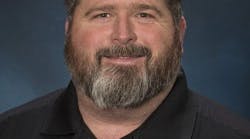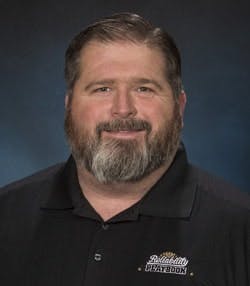Best practices for updating best practices
Paul Dufresne is chair of the Society for Maintenance and Reliability Professionals’ best-practices committee and the SMRP’s 2017 Volunteer of the Year. In his role as best-practices committee chair, Dufresne led the review and revision of all 69 of the SMRP’s best-practices metrics, heading a team of around 15 volunteers to create a new version of the best-practices document. Previously a reliability improvement specialist at Georgia Pacific (in his second of two stints with the company) and reliability group leader at Koch Fertilizer, Dufresne now works as an independent reliability adviser in Central Florida. He spoke recently with Plant Services’ Thomas Wilk and Christine LaFave Grace about effective project leadership and strategies for productive collaboration.
PS: How did you become involved with SMRP, and why was getting involved in the best-practices committee important to you?
PD: I’ve been a member of SMRP going all the way back to 2007, I think; that’s when I earned my CMRP. I’ve always been a student of the game, and I was always wanting to learn more and also network and get to know people. I reached out to volunteer to be on the best practices committee, and for a couple of years it never really materialized. Instead of getting frustrated, I really just stayed after it. And then I would say in probably late 2009, early 2010, I finally got fully engaged in the best practices committee. And I’ve been on that committee actively for the past eight years.
(We’ve been) going through reviewing metrics, developing the hierarchy of metrics – basically looking for ways to get what has been developed and, you know, improve on it, make it better, or find better ways that we can utilize that information to get it out to folks in what I would call the real world. Out in the plants, how they can effectively use this and bring some meaning back to it? We’ve done a lot of good work over the years.
About three years ago, the chair for the best practices committee was coming open. And I said, you know, I think this is something I would be good at, something where I could add value to the organization. It really kind of built on my leadership skills because it’s an all-volunteer committee; nobody on the committee technically works for you. So how do you get a committee of volunteers to effectively get things done?
My goal as committee chair was to really work on developing that next leader within the committee who would step up and take on that role. We’re going to continue the great work that we’re doing on the committee – you know, reviewing our metrics, reviewing our material. And then again as we learn, as new books get written, new presentations are out there; it’s always learning, right? So it’s that evolving, continuous-improvement piece where as we gain more knowledge, we develop a new point of view. It’s (about) challenging our mindset from a few years ago: “OK, what did we learn now; who’s doing it well; how can we take that information and incorporate it into making our product better?”
To be honest with you, I had no idea I was nominated for volunteer of the year until I got an email telling me that I had been selected. You don’t do this for accolades. I do have a passion about maintenance and reliability.
PS: What would you say has been your “stamp” on the committee? What efforts did you seek to continue, and what work did you begin?
PD: I think a couple of things. I don’t know of a better way of saying it, so I’ll just say it: It’s like being in a room of industry experts. Everybody’s got a strong opinion; everybody has a very staunch position on what they believe; and everybody wants to get their point across, and their point is the most important one. I don’t mean that in a negative way.
One of the things I think that lacked on the committee for a long time was we would have an every-three-weeks or a monthly conference call. And we would be on the phone for two or three hours, and it would be an argument. It was like we were using that meeting to really kind of vet everybody’s argument.
From a productivity standpoint, we were getting good things done, but I don’t think we were truly as effective as we could have been. I have a handful of folks on the committee that I talk to outside of the committee on a routine basis. And I would just kind of float an idea, right? A lot of times what I like to do is from a collaborative standpoint, I like to toss up a question and let everybody run with it for a little bit. And then when they bring up key points, kind of hone in on those key points. And I think collectively, we come to a conclusion that we needed to make, but it’s helping others to make it like it was their idea.
I kind of call it a Jedi mind trick. You know, “There’s something that I want to do, but you don’t know that I want you to do that.” I’m going to tee it up, and then I’m gonna let you come to realization that, hey, this is your idea and that’s a great idea, but that’s where we needed to be all along.
It’s all from a good standpoint because everybody is so passionate around maintenance and reliability. I think the biggest thing that I’ve tried to focus on is making sure that everybody on the team felt like a member of the team – that nobody’s idea was dumb or was a bad idea or didn’t have any merit. We want to make everybody feel involved.
Part of the thing that I’ve worked on with the team, too, is helping put some structure back into our committee. Our meetings don’t turn into two-hour-long arguments (anymore); we have a very regimented meeting style. The first few minutes are this; the next few minutes are this – we have a laundry list of things that we go down through. So I think our meetings are extremely more effective and efficient today than what they’ve been in years past. That’s one of the things that I have worked diligently on, and it’s not all me. It’s other folks on the committee as well that have helped develop the format.
We also developed a task force. Our OEE metric within SMRP was outdated. It wasn’t current with industry standards around overall equipment effectiveness. So we basically formed a task force and we had a volunteer step up to lead that task force, and we had a half-dozen folks who participated in it.
They took that off on their own and they basically went back and dissected (the metric), pulled a lot of current industry best practices, and really updated it and brought that back. That was a few-months project, but they did an outstanding job. We didn’t have that years ago.
What we’re looking for is folks who are stepping into these leadership roles. It’s like anything, when you’ve been in that leader’s role for a number of years or a long period of time, it starts to get stagnant; it gets stale.
A year ago I started working on OK, who is going to be my successor? Because I’m only going to be able to take it so far. Somebody else has got to come in with a new set of ideas, a new way so we can continue to grow and move things in the correct direction.
I’ll still be an active member of the committee, but it’s time for somebody else to have the opportunity to step up and lead within an all-volunteer organization. And I believe to be a great leader you’ve got to be a great follower.
PS: What is key in developing out the committee’s up-and-coming leaders and ensuring the robustness of the committee itself?
PD: I think you have a combination of kind of the old guard, folks that have been on the committee for a while, and then we’ve got some new blood, new talent coming in. I think we’ve got a good cross-pollination of that. One of the things that we look to do is we look to pair up some of the folks who are a little bit senior in the organization with some of the new members.
The other thing we worked on is onboarding, because I remember when I first started working on the committee, I didn’t know what was expected of me. So we worked on developing an onboarding process, and it’s ongoing for improvement. Some of the original committee members, we have access to those guys, and if we’re having a debate on a topic, we’ll send them an email in advance and say hey, can you be available on our next call?
We get them on our calls with our new members and even some of our current senior members on the committee. And those guys will spend five or 10 minutes or the whole time on the call making themselves available to answer questions and provide coaching and mentoring.

